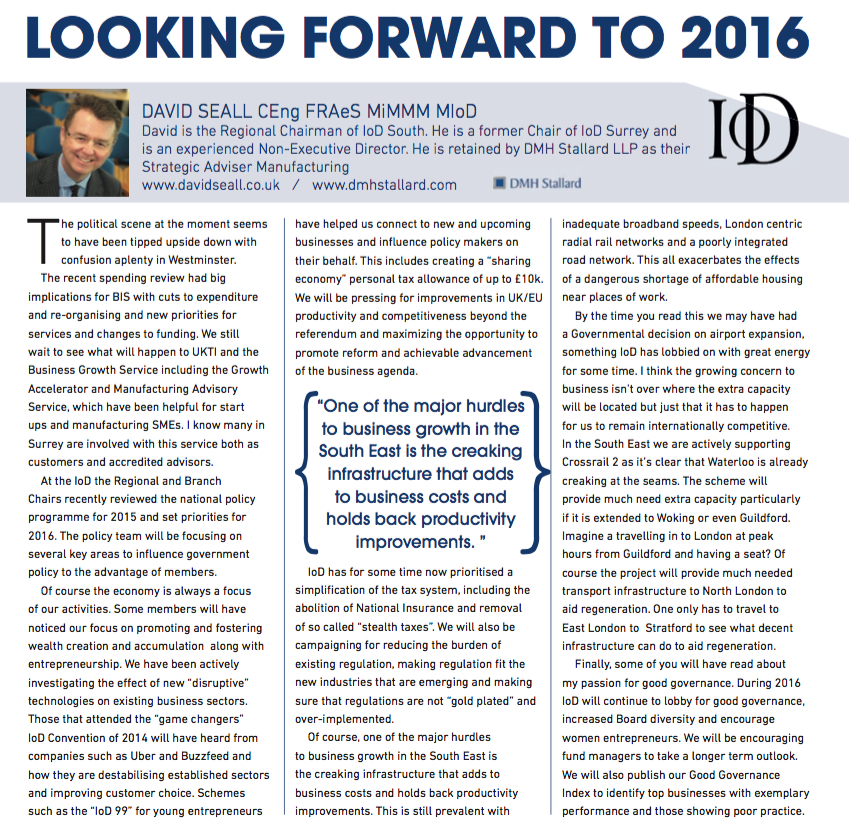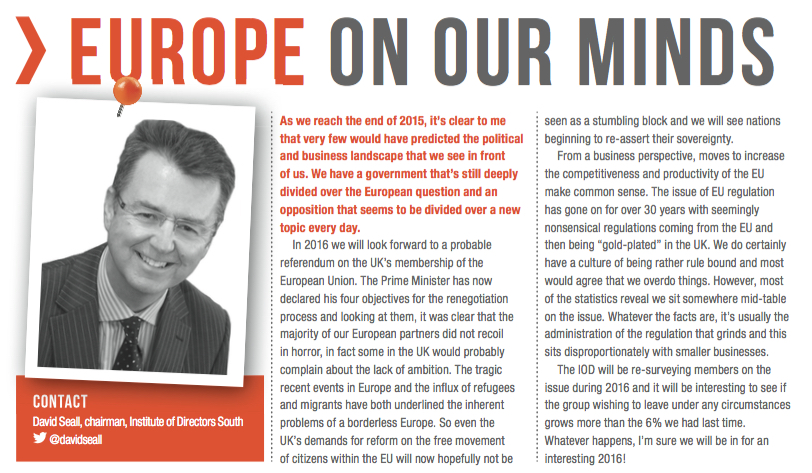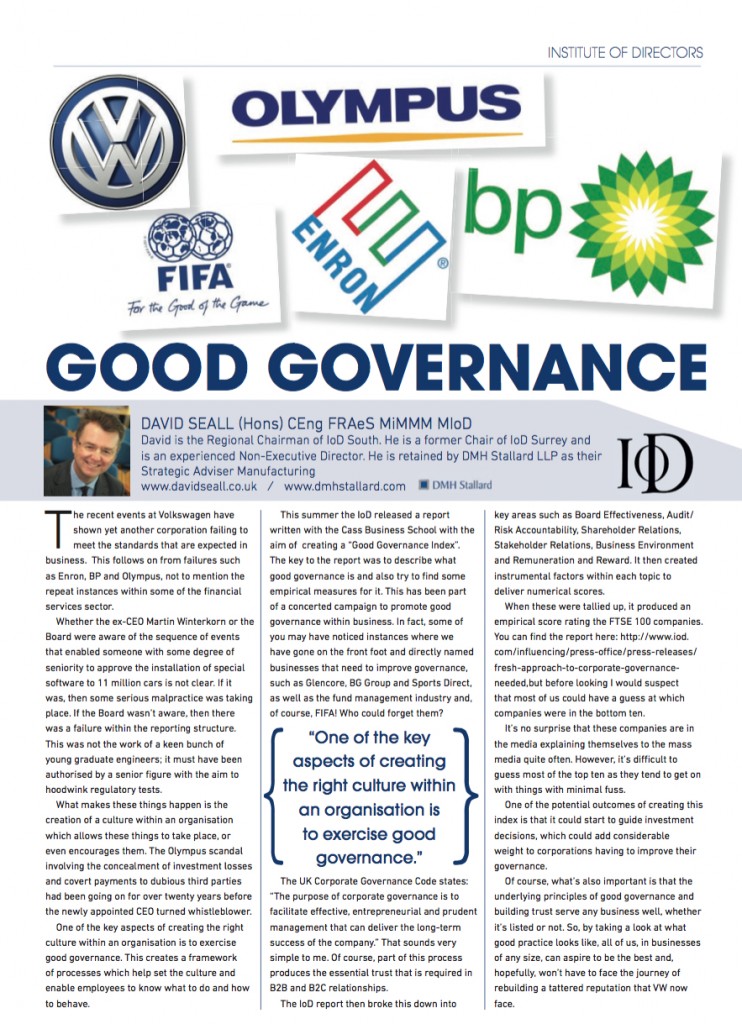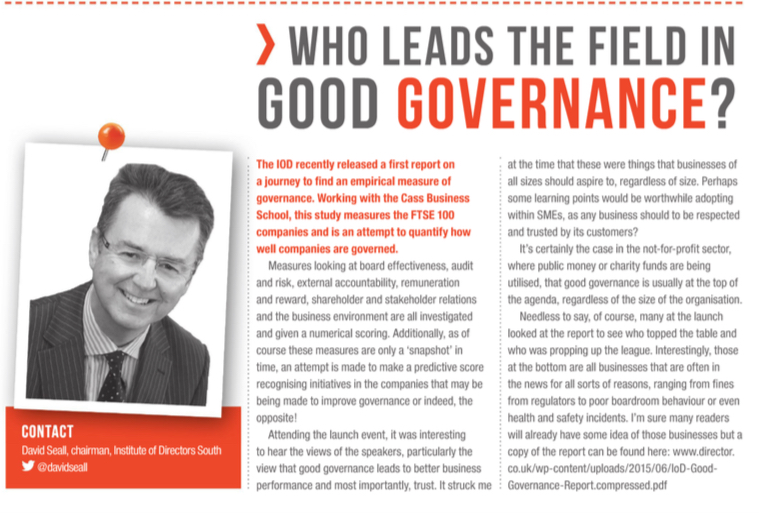
Looking forward to 2016
My December 2016 article for Platinum Business magazine looking forward to issues that will be facing us in 2016
The full magazine can be found here
Crunch time coming for “Brexit” in 2016
My latest article in South East Business magazine
the full article can be found here
New NED position
I’m very pleased to have recently been appointed to the Board of the Cavendish Consortium. Cavendish Enterprise (the trading name of Cavendish Consortium Ltd) is a group made up of six of the largest enterprise agencies across England, together with the National Enterprise Network. Our members are amongst the most prominent not-for-profit enterprise agencies in the country, each with over 30 years’ experience.
All of our members are longstanding agencies within the business support community, and are each respected for their independent and impartial advice and their impeccable probity. Cavendish Enterprise has a reputation for working in close partnership with a variety of organisations from the private, public and third sectors to achieve excellent results in business enterprise.
Recently, three of our members, Nwes, NBV, and Enterprise First, have come together to form Enterprise for London, an initiative to deliver the same support and access to finance within the boroughs of Greater London as the consortium members are delivering across the rest of the country.
Through working together we have successfully delivered government initiatives such as the Growth Vouchers scheme and Ready for Business programme, to thousands of businesses in England. The benefits to these businesses have been both financial and supportive, with qualified advice and training from expert business advisors within each region. By providing support and finance, we are proactively helping the economy by creating jobs, and partnerships for the benefit of both the local and wider communities.
Our most recent initiative, Start & Grow, is funded by the Regional Growth Fund and delivers support and training to potential entrepreneurs across England. The programme is available to those looking to start a business which expects to employ people from its early stages and where start-up financing will be required to get the venture off the ground.
The Volkswagen debacle and the lack of good governance
With every day that passes we see a further unravelling of the disaster that’s affecting VW Group. It’s been interesting to see how this has affected their multitude of brands and how it will impact on new models, R&D and motorsport programmes.
A further development of the story was the amazing “transfer” of a Non-Executive Director from the Daimler AG Board to its ailing competitor. The reason being that Daimler were worried that the saga was permanently damaging the image of German manufacturing.
Christine Hohmann-Dennhardt will take up a Board position on 1st January to oversee “integrity and legal affairs”. She will be the first woman on the VW Board of Managers. One can’t help thinking that a lack of Board diversity led to some of their problems in the first place. Certainly an all-male culture probably wouldn’t have helped.
Unfortunately, by leaving the Daimler AG Board she will leave them with an all male Board unless she is replaced appropriately, so let’s hope that they act accordingly.
The global impact of this debacle is huge and in the UK alone the total number of cars affected is as follows
- VW passenger cars – 508,276
- Audi – 393,450
- SEAT – 76,773
- Skoda – 131,569
- VW commercial vehicles – 79,838
That all adds up to 1,189,906!
The potential consequential costs to consumers and businesses could be huge and I’ll probably cover that in another post.
Interestingly I recently attended an excellent event at IoD Pall Mall, where the issue of Boardroom culture was discussed following a keynote speech by Baroness Neville-Rolfe the BIS Minister. A panel of experts agreed that greater diversity within a Board was a pre-requisite, one could say essential, when achieving good governance. An interesting outcome was a test for any business to determine how they would define what business culture is and then describe the culture of their own business to a stranger. Thought provoking stuff!
Also there were some interesting “red flags” identified to identify a company with poor culture
- A Board that was “too comfortable”
- An excessively confident CEO
- Lack of challenging on the Board
- A feeling of perfection leading to complacency
I’m sure we’ve all seen one or two of those.
My latest article in Platinum Business magazine covers this topic and can be found here.
The full magazine can be found here
Discussing the thorny issue of immigration
My recent article in South East Business Magazine discusses the thorny topic of immigration and what it means for the business community.
Immigration seems to be a political “hot potato” for any Government but the events of the last few months have made it top of the news agenda.
The UK Government’s position of achieving a net migration figure of 100,000 (which includes foreign students who make a considerable contribution to our balance of payments by the way) has led it into position where it is at odds with much of the business community. In fact the Home Secretary Theresa May’s speech at the recent Conservative Party Conference was greeted by the IoD Director General Simon Walker as “irresponsible rhetoric” and “nonsense” http://www.iod.com/influencing/press-office/press-releases/businesses-astonished-by-anti-immigration-rhetoric
All pretty heated stuff!
You can find the copy of my article here http://www.southeastbusiness.com/print-edition/october-november-2015
New column in “Platinum Business”
Mt new column in Platinum Business magazine launched this month, some more contentious topics to come for sure!
Time to celebrate successful leadership
Those of you who attended the Gala Dinner for the IoD London and South East Director of the Year awards back in the spring, will I’m sure like me, have been very impressed with the excellent leadership demonstrated by those nominated.
The nomination process for the 2015 awards has now begun and the new website can be found here http://www.iod-awards.co.uk
The categories include
Small Company
Open to directors of companies with an annual turnover of under £9.99M.
Medium Company
Open to directors of companies with an annual turnover of £10M-£99.99M.
Large Company
Open to directors of companies with an annual turnover of over £100M.
International
Open to all directors in UK-based companies with overseas sales. The entrant must be able to show that a minimum of 25% of the company’s turnover comes from overseas sales and must be successful in exporting, and committed to continued growth in the international arena.
Young Director
Open to directors under the age of 42 on the closing dates for entries, who are able to point to outstanding achievements over the past 12 months.
Family Business
Open to directors in the second-generation or more family businesses and will have responded to the specific challenges that face directors in such well established firms.
Leadership in Corporate Responsibility
Open to those directors who are able to demonstrate that, through their direct actions and leadership, their business has made a positive impact on the local community, wider society and/or the environment.
Public/Third Sector
Open to directors in the public sector as well as those working in the third sector and other charitable or not-for-profit organisations.
As always, both members and non-members can be nominated so if you know of an exceptional candidate please visit the website and nominate them.
Let’s celebrate success and reward those who go the extra mile.
Who leads the field in good governance?
My latest article for South East Business Magazine on the issue of good governance
You can find the full article here SE Business article
You can find the full IoD report here IoD report
Evaluating a company Board or management team before making an investment
When a company decides to invest in another business, it’s expected that due diligence is undertaken to audit the finances of the business and that commercial potential is assessed before any decisions are made to proceed with an investment or purchase.
However, in addition to this, what methods do investors or purchasers use in evaluating the management teams of these businesses? Do they investigate and assess both the performance of the team and the way that key individuals work?
I recently conducted some research with colleagues at Ramsey Hall on this topic.
We wanted to explore whether assessments were conducted or if indeed they were conducted, how this was done. We talked to corporate finance professionals, venture capitalists and private equity investors to gain their views and what approaches they observed or utilised.
The questions we asked
When researching the study we wanted to find out how much research did they do to evaluate the Board and key executives during their investigations?
Prior to any investment being made how did the investor evaluate the performance of the incumbent management team?
If they did, did they base their investment decision purely on business performance and factors such as Intellectual property or did they buy into the current management and its potential or was it a combination of these factors?
Did they have one to one meetings with each of the executive team?
Did they conduct third party assessments of the team and individuals?
Assuming that they placed Board Observers on the company Board. How long did they take to evaluate the executive team in situ? Did they use third party evaluations or use the observations of their Board Observers?
When making changes to a company Board, which positions did they usually have to change and in what order did they generally proceed?
Additionally, how did they go about that process, particularly when the individuals may have a share of equity or have participated in the investment in the company?
Research before the deal
It was interesting to explore how investors researched the management teams prior to deciding to invest. It was clear in many PE investments, the PE house was often competing with many others for the deal against other investors and usually under severe time constraints.
This inevitably leads to them having to cut corners in evaluating the management team and in many cases they are not even given the opportunity for direct conversations.
Inevitably, although the PE investor is looking to get as much time as possible with the management team, it struggles to do so in a meaningful manner. This will usually involve the ubiquitous dinner to meet and start building relationships. They may even try and introduce the team to Directors of companies that they have already invested in.
Additionally, some will look at other touch points such as the opinions of suppliers, conversations with former staff or find some way of having informal conversations with those not involved in ” the deal” who have knowledge of the individuals and who may be connected to them in some way.
Evaluation of management teams prior to investment
As stated earlier, the traditional assumption of the investor meeting the management team over a dinner prior to investment still was the norm with some deals.
Some investors however were more sophisticated in their approach. One hired an external consultant to meet with the management team, interview them and create a “people ” report.
Another had an objective to find out if whether the management team were “buyers or sellers”, to discover if some individuals were just looking for an early exit. In this case if that person were valuable to the business they would be ready to engineer a “lock in”.
If a PE investor has gained an exclusivity agreement on the deal then some do undertake psychometric analysis of the management team members looking at individuals, team and some intellectual capacity tests.
Hogan, Myer-Briggs or sometimes Belbin were used to see particularly if there were “camps” in the team and to discover the team dynamic. Additionally in one case, in depth interviews that were structured over three hours were used.
In evaluating an individual’s performance within a business there may be up to ten to fifteen meetings held to establish that individual’s contribution. The buyer works on impressions gained from these. However one interviewee from corporate finance thought that lots of work moved forward on the basis of “impressions” and these are not challenged thoroughly.
Underlying the evaluation the objective would be to establish if there’s a functioning team operating within the business and if and why the owner is exiting the business.
Additionally, if the business has a sales led CEO/MD with an entrepreneurial spirit then some investors feel comfortable and confident knowing that that individual knows the calibre of people that they need around them.
As a second round of the process one PE house liked to get their people to spend a full day with each of the management team in order to try and get some immersion in the business.
Later on before completion they liked to take a good look at the second tier of leadership by looking at 360-degree assessments particularly searching for those that may be able to step up a level.
It was clear to several investors that they saw management team evaluation as a key part of their structured process and that the results would be shared across the investment committee.
Companies that were purchasing 100% of the equity in a business had a slightly different approach, particularly if it meant buying out the shares of individuals who would be remaining in the business. In this case they effectively became the new owners of the business bringing it into their corporate group.
Typically if a business is brought into a corporate environment and taken over they buyer normally demotes the incumbent executives and only the MD and FD remain as Directors. The key thing of utmost importance for these investors is building trust with the team of the business they are investing into as there will be a wholesale change of ownership and the investor wants to maintain a longer term relationship with the business over at least a five to six year period.
Third party assessments
It was surprising that apart from psychometric assessments, how few buyers brought in third party assistance in evaluating the management team. These usually consist of “people reports” written after one-to-one interviews.
Interestingly one investor waits until the investment is complete before conducting any psychometric evaluation.
Using Board Observers post investment
Once an investment or purchase has been made nearly all investors use Board Observers or Monitor Directors. More often than not they are often part of the investor team that did the deal or brought it to the investor.
Within this, a new chairman is placed 80% of the time
Most PE houses have a panel they look to for non-execs or they have relationships with key executive Search partners with extensive networks databases to find them. They may approach third parties such as banks, lawyers or accountancy firms to find suitable candidates.
Obviously they look for people to help drive the business forward and who are complimentary to the team. The non-execs are usually paid a fee funded by the business itself, they may also be an investor or an individual who will work for “sweat equity” in the company
The observer usually monitors KPIs and reports back to the investor.
Changing the management team post investment
When investing in an existing team we saw a lot of evidence where the investor tries very hard not to have exits from the existing owner managers. On an initial view this seems counter intuitive but it’s worth reflecting that the investor will have decided to back that management team before investing in the first place. The investor usually adds Non-Executive Directors to make up for leadership deficiencies or skills gaps in the Boardroom.
On the whole, the investors tend to take around a year before dealing with poor performers with the business they have invested in. Some investors conduct “Board Effectiveness” reviews at this time to reflect post investment and plan and changes or enhancements that they think are necessary.
Not surprisingly, MDs and FDs are closely observed followed by Operations. Commercial and technical team members are left well alone. One investor was of the opinion that there was a dire shortage of “strategic” FDs in the UK with “bean counters” being the norm.They also thought that there was a dearth of talent in HR and Commercial and this is usually a gap in most management teams
They also tend to dance around those who are major investors and perhaps focus more on the second tier and work around the investor incumbent.
If they do exit an investor member of the management team it’s usually via a one to one chat, fully open with cards on the table. This is usually a task for the Chairman. We did however come across an instance where an MD was removed immediately post-deal with the investor obviously not seeing that individual in their plans for taking the business forward.
If a structured exit is difficult, a compromise agreement will be made and if the person involved has equity within the business this will be compensated for or they may able to keep their shareholding but not be part of this business moving forward.
In summary
We found from our discussions exploring this topic that there’s a very mixed picture. A huge factor hanging over the process, particularly with PE investments, are the time constraints involved. The investor simply isn’t given time to meet the leadership of the company it’s investing into and when and if they are given exclusivity the deal must proceed in haste. This inevitably leads to the acceleration of processes so that corners have to be cut when evaluating people.
This is acknowledged as not an ideal scenario. Of course a “heavy hand” in evaluating the leadership of a business by the investor prior to completion of the deal could be seen as a threat leading to that leadership within the business seeking investment doing their best to scupper the deal.
Therefore, a distinct trend observed was for investors to address any issues post investment by firstly bringing in non-executive talent. They would then appropriately managing the executives in that business and as a last resort, part company with those in leadership positions holding equity in the business. The best option was certainly to recruit external talent paid for by investee.
Notwithstanding this, it’s clear that subject to the financial expectations of the business making it an attractive proposition to an investor and them seeing the opportunity to make a difference and grow it further, the issue of evaluating the team and key individuals, is seen an important factor by investors and one that the majority seek to address in whatever way they can.
PyTerra in “The Water Report”
My colleague David Arscott has written an interesting article on the future of water services along with colleagues from Ricardo-AEA and WSP.
It details how the delivery of water services could be reformed by democratising, integrating and optimising the delivery of those services and how the case Integrated Water Resource Management can be driven.
The article can be found here Article on the PyTerra website









Recent Comments